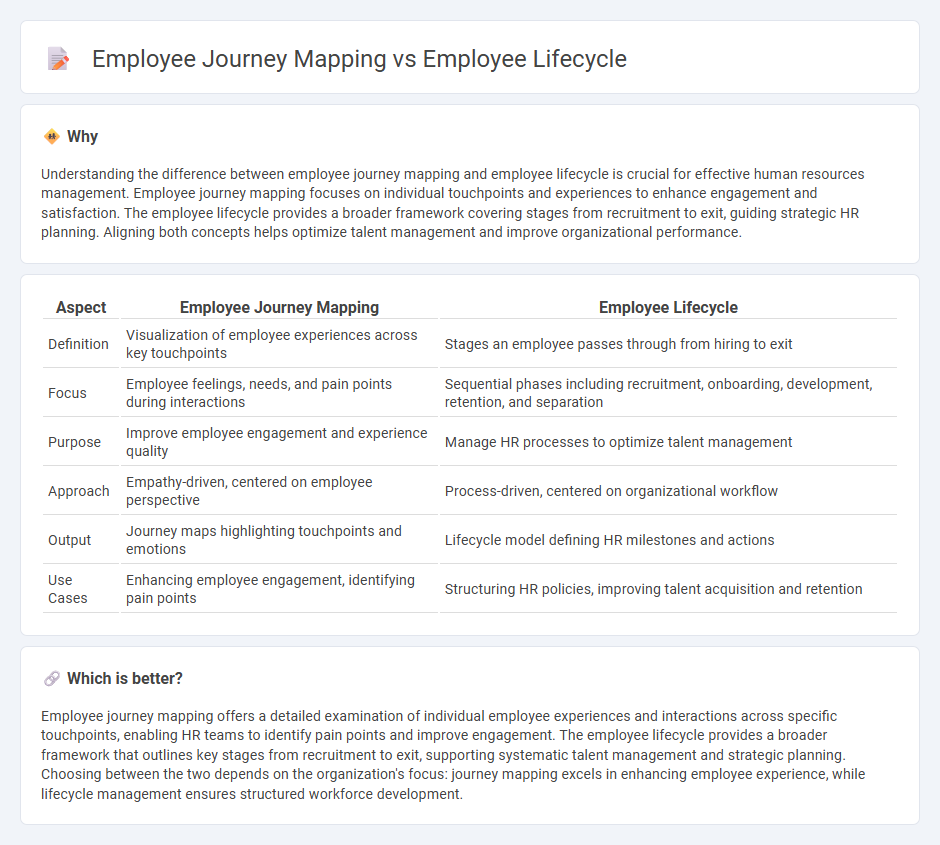
Employee journey mapping focuses on visualizing the individual experiences and touchpoints employees encounter within an organization, highlighting emotions and interactions at each stage. In contrast, the employee lifecycle outlines the broader phases of employment from recruitment to exit, emphasizing processes and organizational milestones. Explore detailed insights to understand how these concepts drive effective HR strategies.
Why it is important
Understanding the difference between employee journey mapping and employee lifecycle is crucial for effective human resources management. Employee journey mapping focuses on individual touchpoints and experiences to enhance engagement and satisfaction. The employee lifecycle provides a broader framework covering stages from recruitment to exit, guiding strategic HR planning. Aligning both concepts helps optimize talent management and improve organizational performance.
Comparison Table
| Aspect | Employee Journey Mapping | Employee Lifecycle |
|---|---|---|
| Definition | Visualization of employee experiences across key touchpoints | Stages an employee passes through from hiring to exit |
| Focus | Employee feelings, needs, and pain points during interactions | Sequential phases including recruitment, onboarding, development, retention, and separation |
| Purpose | Improve employee engagement and experience quality | Manage HR processes to optimize talent management |
| Approach | Empathy-driven, centered on employee perspective | Process-driven, centered on organizational workflow |
| Output | Journey maps highlighting touchpoints and emotions | Lifecycle model defining HR milestones and actions |
| Use Cases | Enhancing employee engagement, identifying pain points | Structuring HR policies, improving talent acquisition and retention |
Which is better?
Employee journey mapping offers a detailed examination of individual employee experiences and interactions across specific touchpoints, enabling HR teams to identify pain points and improve engagement. The employee lifecycle provides a broader framework that outlines key stages from recruitment to exit, supporting systematic talent management and strategic planning. Choosing between the two depends on the organization's focus: journey mapping excels in enhancing employee experience, while lifecycle management ensures structured workforce development.
Connection
Employee journey mapping visualizes each stage of the employee lifecycle, from recruitment to exit, enabling HR professionals to identify key touchpoints and improve employee experience. This strategic alignment helps optimize talent acquisition, onboarding, development, retention, and offboarding processes. Integrating these tools enhances workforce engagement, productivity, and overall organizational performance.
Key Terms
**Employee Lifecycle:**
The Employee Lifecycle encompasses all stages from recruitment, onboarding, development, retention, to exit, providing a comprehensive framework for managing talent effectively. This model helps HR professionals optimize each phase to boost employee engagement, productivity, and retention rates. Explore deeper insights to leverage Employee Lifecycle strategies for maximizing organizational success.
Recruitment
Employee lifecycle encompasses the complete phases of an employee's tenure from recruitment and onboarding through development and retention to exit, providing a structured overview for HR management. Employee journey mapping during recruitment focuses specifically on candidates' experiences, highlighting pain points and opportunities within the hiring process to enhance engagement and reduce drop-off rates. Explore in-depth strategies to optimize recruitment by integrating lifecycle insights with journey mapping techniques.
Onboarding
Employee lifecycle onboarding emphasizes structured processes from recruitment to integration, ensuring compliance and role clarity. Employee journey mapping highlights the new hire's emotional experience, identifying pain points to enhance engagement and retention. Discover how combining both approaches transforms onboarding for lasting success.
Source and External Links
Employee Life Cycle: The Ultimate Guide for HR [+Free Flowchart] - The employee life cycle describes the seven stages--attraction, recruitment, onboarding, retention, development, offboarding, and happy leavers--that every employee journeys through at a company, with the goal of ensuring a positive, holistic experience throughout their tenure and beyond.
What is the Employee Life Cycle? Optimising The 7 Stages - The employee life cycle consists of seven key phases: attraction, recruitment, onboarding, engagement, development, retention, and exit & advocacy, each designed to foster positive relationships and experiences for employees within the organization.
What is the Employee Life Cycle? HR Guide to the 6 Stages - Personio - The employee life cycle model outlines six main stages--attraction, recruitment, onboarding, retention, development, and separation--each playing a distinct role in an employee's journey and the organization's ability to manage talent and turnover.
 dowidth.com
dowidth.com